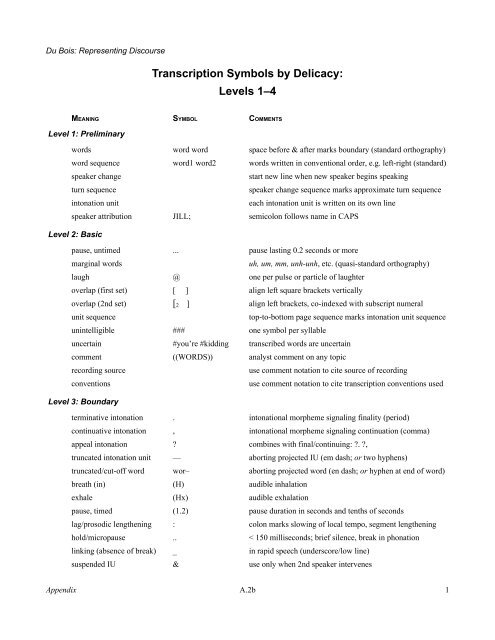Transcription Symbols by Delicacy: Levels 1–4 - UCSB Linguistics
Transcription Symbols by Delicacy: Levels 1–4 - UCSB Linguistics
Transcription Symbols by Delicacy: Levels 1–4 - UCSB Linguistics
You also want an ePaper? Increase the reach of your titles
YUMPU automatically turns print PDFs into web optimized ePapers that Google loves.
Du Bois: Representing Discourse<br />
<strong>Transcription</strong> <strong>Symbols</strong> <strong>by</strong> <strong>Delicacy</strong>:<br />
<strong>Levels</strong> <strong>1–4</strong><br />
MEANING SYMBOL COMMENTS<br />
Level 1: Preliminary<br />
words word word space before & after marks boundary (standard orthography)<br />
word sequence word1 word2 words written in conventional order, e.g. left-right (standard)<br />
speaker change start new line when new speaker begins speaking<br />
turn sequence speaker change sequence marks approximate turn sequence<br />
intonation unit each intonation unit is written on its own line<br />
speaker attribution JILL; semicolon follows name in CAPS<br />
Level 2: Basic<br />
pause, untimed ... pause lasting 0.2 seconds or more<br />
marginal words uh, um, mm, unh-unh, etc. (quasi-standard orthography)<br />
laugh @ one per pulse or particle of laughter<br />
overlap (first set) [ ] align left square brackets vertically<br />
overlap (2nd set) [2 ] align left brackets, co-indexed with subscript numeral<br />
unit sequence top-to-bottom page sequence marks intonation unit sequence<br />
unintelligible ### one symbol per syllable<br />
uncertain #you’re #kidding transcribed words are uncertain<br />
comment ((WORDS)) analyst comment on any topic<br />
recording source use comment notation to cite source of recording<br />
conventions use comment notation to cite transcription conventions used<br />
Level 3: Boundary<br />
terminative intonation . intonational morpheme signaling finality (period)<br />
continuative intonation , intonational morpheme signaling continuation (comma)<br />
appeal intonation ? combines with final/continuing: ?. ?,<br />
truncated intonation unit — aborting projected IU (em dash; or two hyphens)<br />
truncated/cut-off word wor– aborting projected word (en dash; or hyphen at end of word)<br />
breath (in) (H) audible inhalation<br />
exhale (Hx) audible exhalation<br />
pause, timed (1.2) pause duration in seconds and tenths of seconds<br />
lag/prosodic lengthening : colon marks slowing of local tempo, segment lengthening<br />
hold/micropause .. < 150 milliseconds; brief silence, break in phonation<br />
linking (absence of break) _ in rapid speech (underscore/low line)<br />
suspended IU & use only when 2nd speaker intervenes<br />
Appendix A.2b 1
Du Bois: Representing Discourse<br />
MEANING SYMBOL COMMENTS<br />
sentence start Capital initial Capitalize for beginning of new discourse "sentence"<br />
pseudograph ~Jill name change to preserve anonymity (tilde)<br />
index/line numbers 1 number each line for referencing<br />
timestamp time in seconds from start of recording<br />
Level 4: Interaction<br />
vocalism (COUGH) various notations: (SNIFF), (SOB), (YAWN), etc.<br />
click (TSK) alveolar click<br />
glottal stop, creak (%) separate vocalism = separate “word”<br />
manner/quality various notations for manner of speaking<br />
laughing words @you’re @kidding laugh symbol marks laughter during each word<br />
laughing words words marks laughter during words (for 7+ words)<br />
vox voice of another<br />
quotation quality quote voice that is less than a true vox<br />
gesture, gaze, body, co-action see references on transcribing video<br />
participation framework JILL/TEL; slash symbol precedes interactional context or frame<br />
role voicing JILL=JIM; speaker speaks in role of another<br />
recipient JILL\DOG; backslash symbol precedes addressee<br />
non-interactive agent ±COMPUTER; marks source or agent of sound or event<br />
multiple speakers JILL+JIM; for simultaneous joint action of individuals<br />
group of speakers AUDIENCE++; for simultaneous joint action of crowd<br />
code-switch words switching between languages<br />
code-switch (lg. specified) switching between languages<br />
[rev. 23-Jun-2006]<br />
Appendix A.2b 2
















